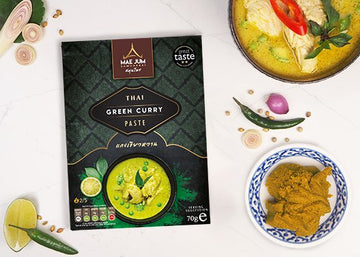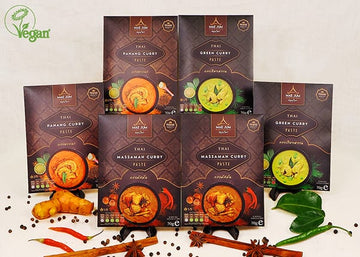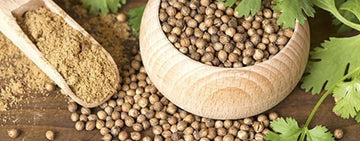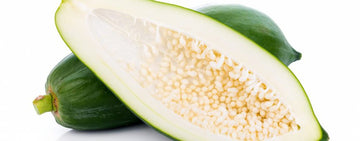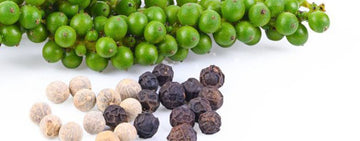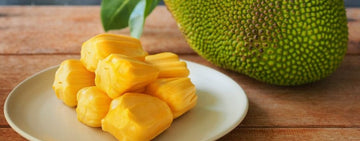Everything You Need to Know About Coriander: A Versatile Herb in Thai Cuisine
Coriander is a herb that has been cherished for centuries, not only for its culinary applications but also for its health benefits. From its distinct aroma and refreshing flavour to its role in traditional medicine, coriander is a versatile ingredient that enhances many dishes, particularly in Thai cuisine. In this blog, we’ll explore the different parts of the coriander plant, its uses in cooking, the unique flavour profiles of its leaves and seeds, and the health benefits it provides.
What is Coriander?
Coriander, also known as Coriandrum sativum, is a herb from the parsley family. The plant produces round, tan-coloured seeds, and every part of it—the seeds, leaves, stems, and even roots—can be used in cooking. The term “coriander” typically refers to the entire plant, but it’s important to note that the seeds and leaves are used in very different ways and bring distinct flavours to dishes.
In the UK and most parts of the world, coriander refers to both the fresh leaves and the seeds of the plant. However, in North America, the fresh leaves are often called cilantro, while the seeds retain the name coriander. This duality can sometimes cause confusion, but understanding the unique characteristics of each part of the plant is essential for unlocking its full potential in the kitchen.

The Flavour Profile of Coriander
Coriander seeds and coriander leaves are quite different in terms of flavour and cannot be substituted for one another. Each part of the plant brings a unique taste to dishes.
Coriander Seeds
Coriander seeds have a pleasant, lemony, floral aroma. When ground, they release a slightly nutty, citrusy flavour with a touch of sweetness. The seeds are often paired with cumin seeds, as the two spices complement each other perfectly, especially in curry powders and spice blends.
The seeds are used extensively in Thai cuisine, often dried, roasted, and ground into a powder to season dishes. Their flavour is mild enough to enhance other spices without overpowering them, making coriander seeds a versatile addition to a wide range of recipes.
Coriander Leaves
In contrast, coriander leaves have a bold, pungent flavour that can be divisive. For those who enjoy coriander, the leaves provide a refreshing, citrusy taste reminiscent of lime. However, some people find the taste soapy, a reaction thought to be linked to genetics. Love it or hate it, coriander leaves add a bright, zesty note to many dishes, and in Thai cuisine, they are frequently used as a garnish or added just before serving to preserve their fresh flavour.
Coriander Root: The Unsung Hero
While the leaves and seeds of coriander are well known, coriander root is an essential but often overlooked ingredient in Thai cooking. Coriander root, also known as Chinese parsley root, has a more intense flavour than the leaves or seeds and is highly aromatic. The roots are often pounded into curry pastes, where their deep, earthy flavour adds a robust base to many Thai dishes.
Coriander root is often harder to find in mainstream supermarkets, but it’s readily available in Asian grocery stores. If you’re serious about cooking authentic Thai food, seeking out fresh coriander root is well worth the effort. It’s a critical ingredient in traditional Thai curries, soups, and marinades, and its intense aroma and flavour elevate any dish.
Storing Coriander: Keeping It Fresh
Coriander, like most fresh herbs, has a limited shelf life. However, with the right storage techniques, you can extend the freshness of both the leaves and the roots.
- Coriander Leaves: To keep coriander leaves fresh, trim the ends of the stems and place them in a glass of water, much like you would with fresh flowers. Cover the leaves loosely with a plastic bag and store the glass in the fridge. This can keep the leaves fresh for up to a week. Alternatively, you can wrap the leaves in a damp paper towel and store them in a plastic bag in the fridge.
- Coriander Root: Coriander root can last up to two months if stored properly. Wrap the roots in a damp paper towel and place them in a plastic bag before refrigerating. If you don’t plan to use them immediately, coriander roots can also be frozen. Simply clean and trim the roots, then store them in an airtight container or freezer bag for future use.

How Coriander is Used in Thai Cuisine
Coriander has been a staple in Thai cooking for centuries, and its versatility makes it a crucial ingredient in many recipes. Whether you’re using the seeds, leaves, or roots, each part of the coriander plant plays a unique role in Thai cuisine.
Coriander Seeds in Thai Dishes
Coriander seeds are commonly used in curry powders, where they are roasted and ground with other spices such as cumin, turmeric, and chilli. The seeds add a mild, citrusy warmth that balances the spiciness of the chillies and the richness of the other ingredients.
In addition to curries, coriander seeds are also used in seasoning blends for meat and fish dishes, where their subtle flavour enhances the natural taste of the ingredients. For example, in Thai grilled chicken or Gai Yang, ground coriander seeds are mixed with garlic, soy sauce, and other spices to create a marinade that infuses the meat with a deep, complex flavour.
Coriander Leaves as Garnish
The leaves of the coriander plant are typically used as a garnish or added at the last minute to maintain their fresh, bright flavour. You’ll often find coriander leaves sprinkled over Tom Yum soup, curries, stir-fries, and salads. Their pungent, citrusy aroma provides a refreshing contrast to the richness of coconut-based curries or the spiciness of chilli-laden soups.
Coriander leaves are also used in fresh herb salads alongside other herbs like Thai basil and mint, where their bold flavour enhances the freshness of the dish.
Coriander Root in Thai Pastes
Coriander root is a key ingredient in many Thai curry pastes. Unlike the leaves, which are added raw or at the end of cooking, the roots are typically pounded into pastes with garlic, chilli, and lemongrass to form the base of Thai curries. The flavour of coriander root is deeper and more robust than the leaves, making it ideal for slow-cooked dishes where the flavours have time to develop.
One of the most famous Thai dishes that uses coriander root is Tom Yum, a hot and sour soup known for its complex flavour profile. Coriander root helps to deepen the savoury notes in the soup, complementing the brightness of the lemongrass and lime leaves.
Health Benefits of Coriander
Coriander isn’t just a fantastic flavour enhancer—it’s also packed with health benefits. Both the seeds and leaves contain vitamins, minerals, and antioxidants that can support your overall health.
1. Rich in Antioxidants
Coriander is a natural source of antioxidants, compounds that help protect the body from free radicals, which can cause oxidative stress and lead to chronic diseases. Antioxidants in coriander may help reduce inflammation and support heart health, making it a valuable addition to a balanced diet.
2. Supports Digestive Health
Coriander seeds have long been used in traditional medicine to aid digestion. The compounds in coriander seeds can help stimulate the production of digestive enzymes, making it easier for the body to break down food. Drinking coriander tea made from the seeds is a common remedy for indigestion, bloating, and gas.
3. May Help Regulate Cholesterol Levels
Coriander seeds may also help regulate cholesterol levels. Some studies suggest that coriander seeds can reduce bad LDL cholesterol and increase good HDL cholesterol, contributing to improved heart health. While more research is needed, adding coriander to your diet could potentially have heart-protective benefits.
4. May Lower Blood Pressure
Coriander has been used in traditional medicine to help lower blood pressure. Some research suggests that the herb’s ability to promote relaxation in blood vessels can contribute to reducing blood pressure, which is beneficial for heart health.
5. Anti-Bacterial and Anti-Fungal Properties
Coriander has natural anti-bacterial and anti-fungal properties, which can help protect the body against infections. It has been used in traditional medicine to treat skin conditions, including eczema and fungal infections, and may help improve overall skin health when applied topically.
Conclusion: Coriander in Your Cooking and Beyond
Coriander is a versatile herb that has earned its place as a staple in Thai cuisine. From the seeds and leaves to the powerful, aromatic roots, every part of the coriander plant offers unique flavours that enhance a wide variety of dishes. Whether you’re making curry pastes, garnishing soups, or adding depth to marinades, coriander is an essential ingredient that brings freshness, complexity, and warmth to your cooking.
Beyond the kitchen, coriander’s health benefits make it an even more valuable addition to your diet. With its antioxidant properties, ability to support digestive health, and potential heart health benefits, coriander is more than just a delicious herb—it’s a powerhouse of nutrients.
So next time you’re preparing a Thai dish or simply looking for a way to elevate your meal, reach for coriander in all its forms. Whether you’re working with the seeds, leaves, or roots, you’ll be adding both flavour and nutrition to your plate.
If you enjoyed reading about the uses of coriander in Thai cuisine, please give this post a rating and subscribe for new blog updates and recipes. Follow and tag us @maejumsamunprai on social media for great foodie content and giveaway competitions! Read more on our blogs today!
